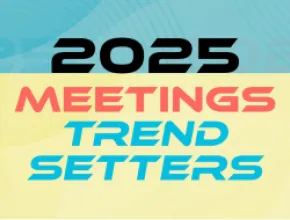
Meeting planners are masters of so many things. From seating charts and food flow to strategic meeting management, meeting planners are the Swiss army knives of the working world!
And now meeting planners have one more thing to master: hybrid technology.
If you’re like many meeting planners who survived COVID-19 professionally, you may be ready to turn your head and hope to avoid having to learn one more thing. I’ll share why it’s worth it to invest in learning hybrid technology and strategy, which will help to make yourself even more relevant in the “New Norm.”
[Related: 6 Easy Steps to Defeat Virtual Meetings Fatigue]
Reasons Why Hybrid Meetings Matter
- Increased attendance: Hybrid creates a new opportunity with significant demand. A recent government social media conference I worked on had 800 in-person attendees and 600 virtual attendees. Many virtual attendees said they could NOT attend if there was not a virtual ticket available.
- Increased revenue: Ticket sales for the virtual component of a hybrid conference generated $300,000 in additional revenue for the above government social media conference.
- Attendees are ready: COVID-19 prepared even the most tech-resistant attendees to be able to effectively attend a virtual meeting.
[Related: 6 Ways to Save on Hybrid Meeting Production Costs]
Understanding Hybrid Events
To help you understand the basics of hybrid meetings, I’ll divide it into three categories:
Level 1: Broadcast
Just turn on a camera and provide the video feed to a virtual audience. This is the easiest, but is also the least engaging if a virtual MC is not used.
Level 2: Interact
Where at least one person from virtual can talk to in-person attendees and/or vice versa. This requires more work, as you will most likely need more than one camera. You may also need more than one microphone. You’ll also need more technical expertise to prevent challenges such as connectivity and audio echo.
Scenarios include the following: A virtual speaker keynoting to an in-person and virtual audience; an in-person speaker keynoting to an in-person and virtual audience; and/or an in-person keynoter taking a question from a virtual attendee.
[Related: Key Tips to Create Engagement for a Hybrid Event]
Level 3: Collaborate
This is where everybody from the virtual program can talk to everybody in the in-person audience and vice versa, and requires even more technology. For large audiences this eventually becomes undoable—even at 20 microphones it becomes undoable UNLESS you have array microphones that are able to "hear" a room without echo.
One example is a board meeting where 10 people are in-person and 10 people attend virtually. All 10 in-person attendees are connected with their laptop and disconnect their audio. Then a sound engineer uses 10 microphones—one for every in-person attendee—to prevent echo. Two large-screen televisions will be used to feature the virtual speaker in full size and the gallery to see the other virtual attendees.
In this scenario, the board will be able to complete its yearly strategy and budget in the same amount of time as their previous all in-person retreats, but at considerably less cost and more convenience because many of the board members will not have to travel to attend.
More Reasons Why Hybrid Should Be Considered
One benefit of the evolution of conferencing technology due to the COVID-19 pandemic is that the tech to run a hybrid meeting is now much more accessible in cost and training. While a professionally produced program used to cost $100,000 or more, a similar program can now be produced for just thousands of dollars using off-the-shelf, and sometimes free, software.
Successful meeting professionals know what their strong suits are and what is not in their wheelhouse. When you choose to go hybrid, technology needs to be your passion, or you need to find the qualified partners to take care of your client and thus make you successful.
Discover More Hybrid Meetings Resources







